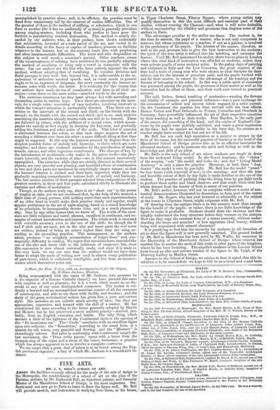FINE ARTS.
ME. J. Z. BELL'S SCHOOL OF ART.
AMONG the facilities recently offered for the study of the arts of design in the Metropolis, the establishment of a school of art on the plan of the Parisian ateliers, by Mr. Zephaniah Bell, an historical painter, and formerly Master of the Manchester School of Design, is the most important. Stu- dents need not now go to Paris to learn to draw the figure well. Mr. Bell will provide models, and instruction in studying from them, at his house,
in Upper Charlotte Street, Fitzroy Square; where young artists may qualify themselves in this the most difficult and essential part of their studies, without crossing the Channel—and, what is still more desirable, without encountering the ribaldry and grossness that disgrace some of tin; ateliers in Paris.
The advantages peculiar to the atelier are these. The student is, for the time he attends, the pupil of a master, who is not only competent to instruct, but whose reputation as a teacher, if not as a painter, is involved in the proficiency of his pupils. The interest of the master, therefore, as well as his zeal, prompts him to give the best instruction to the students; the spirit of the true artist is infused into his teaching, and animates the learner. Until Mr. Bell announced his atelier, there was no place in London where this vital kind of instruction was afforded to students, unless they were private pupils of some eminent artist. In the palmy days of painting and sculpture in Italy and the Low Countries, the great masters of the time had a train of young men who were chosen as their disciples for their talents, not for the amount of premium paid; and the pupils worked with and for their master, in return for the advantage of his teaching and the honour of belonging to his school. In this way a noble spirit of emulation was generated among the pupils, the greatness of their master as well as his instruction had its effect on them, and their work soon turned to practical account.
The cold, listless, formal teaching of academies—wanting the fervour and vitality of example and personal influence—was a poor exchange for the communion of ardent and earnest minds engaged in a noble pursuit. On the Continent the practice has been revived with the best effects. Horace Vernet and Paul Delaroche in France, Cornelius and Overbeck in Germany, have powerfully influenced the art of their respective countries by their teaching as well as their works. Poor Hayden, in the early part of his career, did something of the kind; and the copies of Raphael's Car- toons by his pupils were publicly exhibited, and made a great impression at the time: had he opened an atelier in his later day, his success as a teacher might have averted the last sad act of his life.
Mr. Bell has not such high reputation as a painter to attract by the force of his name, but his successful practice of teaching at the head of the Manchester School of Design proves him to be an efficient instructor for advanced students; and he possesses the spirit and feeling as well as the knowledge and skill of an artist.
Mr. Bell's is the only school of art where students are taught to draw from the undraped living model. In the Royal Academy, the " visiter" of the evening "sets " the model, and looks on; and the " Living Model Academy " is only a place for practice. Moreover, at both these " Aca- demies" the model is seen by gas-light. Mr. Bell has the model " posed " for four hours (with intervals of rest) in the morning; and thus the true and beautiful colour of flesh by day-light is made familiar to the eye of the student. The practice of painting from the living form by gas-light tends to produce those opake and black shadows and that crude brick-dust hue which detract from the beauty of flesh in many of our painters. Mr. Bell's atelier, however, will not be complete without a series of ana- tomical demonstrations illustrated by dissections, to form part of the course of study. Mr. Rogers, who last year lectured so admirably on the subject at the rooms in Clipstone Street, might cooperate with Mr. Bell.
Of drawing from the antique there is in this country more than enough for the benefit of the pupils; or rather, there is too little knowledge of the figure to make it profitable. Students should draw the skeleton and tho- roughly understand the bony structure before they venture on the antique. How can they copy the external form of a statue correctly, without under- standing the bones and muscles? or how appretiate ideal beauty, without being well acquainted with natural character? It is gratifying to find that the necessity for students in all branches of art to draw the figure well is now generally admitted. The ground broken by Mr. Bell in Manchester has been sown by Mr. Wallis, his successor in the Mastership of the Manchester School of Design; whose removal has enabled him to scatter the seeds of this troth in other parts of the kingdom, where he has been lecturing. The expelled students of the London School have found an able and zealous teacher of the figure in Mr. Leigh, of the Drawing Gallery in Maddox Street.
Apropos to the School of Design, we rejoice to hear it stated that this in- stitution is to be remodelled: we hope it will be on a broad and sound basis.


























 Previous page
Previous page